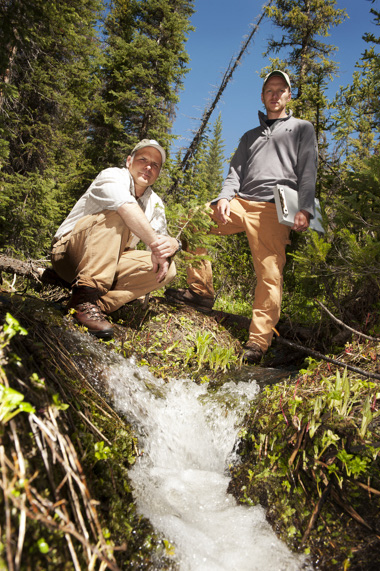 |
| Dr. Scott Miller and one of his graduate students. |
“It was very striking to see the connection between forest management and
severe consequences to people, including loss of life,” Dr. Miller says.
Dr. Miller’s experience in Nepal urged him to pursue an undergraduate
degree in geological sciences. A few years after college he returned to Nepal
to work on a dam project, but quickly realized that he needed more technical
training, which led him to the field of watershed management. Today, Dr. Miller
is a watershed hydrologist at the University of Wyoming.
“The fascinating thing about hydrology and water management is that we
are always in a state of flux,” Dr. Miller says. “And, humans are intimately
connected to water.”
The connection between humans and water is one of the major driving
forces behind the $20 million EPSCoR WyCEHG (Wyoming Center for Environmental
Hydrology and Geophysics) grant, on which Dr. Miller is a co-Principal
Investigator with Dr. Steve Holbrook.
“What happens in Wyoming affects a huge number of people that are outside
of Wyoming,” Dr. Miller says.
Wyoming is the headwater state for many western states. Good water
management is absolutely essential because so many people and such a large
ecosystem downstream depend on it. Understanding water in Wyoming is also
important because there is a high degree of variability in the climate which
dictates how and where water comes from.
“From a hydrological perspective, it is really quite fascinating to work
in Wyoming,” Dr. Miller says. “The vast majority of our moisture that drives
water in rivers and streams occurs at very high elevations. All of our
downstream rivers are dependent on what happens up in the mountains. So, it is
a really interesting place to work because of the significant changes in
climate and hydrology as you travel from the plains up to the headwaters.”
So far, all of the research sites for the WyCEHG grant are located in mountains
throughout the state. This setting is an ideal place for someone like Dr.
Miller to conduct research because it is constantly challenging.
“I like being surprised by observations in the field or outcomes from
models that I didn’t expect,” Dr. Miller says. “It is very stimulating to
tackle something that is not really well understood.”
The water system in Wyoming is one area that fits this description,
especially in terms of in-depth understanding because of the high variability.
As a Watershed Hydrologist, Dr. Miller will be using his expertise to look at
how water is moving through the geologic systems of the mountains and how
altering surface processes change water movement.
“There are a variety of disciplinary ways to tackle water,” Dr. Miller says.
“In my field usually what we do is go out and put instruments in rivers,
measure the flow of water through rivers at various places, look at how much
rainfall or snow is coming in, understand the meteorological signals and then
measure things like soil moisture and ground water depth. Even with this
approach we are still left with an incomplete picture of how water moves
through a system because of the heterogeneity of the subsurface.”
To create a more complete picture of hydrological systems, watershed
hydrologists build models which represent the actual processes occurring in
nature. These models give scientists a spatial perspective of water movement,
but they too are incomplete. The best way to create a complete picture is
through interdisciplinary work across fields. Watershed hydrology, geophysics,
plant ecology and various other fields contribute important information to
water research.
“I feel, and this is the purpose of the grant, that by integrating all
these different disciplines we will do a better job of getting a fuller
portrait of how hydrological systems work,” Dr. Miller says. “The opportunity
to have a significant impact is greater when you work in a team. It’s worth the
effort to overcome the barriers to interdisciplinary work.”
The importance of interdisciplinary collaboration is an experience Dr.
Miller learned and took to heart during a project in Kenya. The project was
based on interaction between scientists and stakeholders, and relied on
positive collaboration in order to benefit the community in which they were
working.
“The place I evolved most rapidly as a scientist was when I was working
in Kenya because of the cultural challenges, the positive outcomes of working
across cultures and the high relevance of the research,” Dr. Miller says. “I
advanced a lot, both as a scientist and as a human being.”
The research funding in Kenya was directed towards impacting people’s
lives and livelihoods, which forced the scientists to focus on the most
relevant aspects of water in order to help the local people. This emphasis on
relevancy is mirrored in the WyCEHG grant, which will help inform water
managers in order to help the people dependent on Wyoming’s water.
“We will hopefully be able to provide a better scientific framework for
understanding what to expect in the next several years regarding water, which
will allow for more appropriate planning,” Dr. Miller says. “If we can improve
scientific understanding, we can improve decisions.”
By Kali McCrackin
Photo courtesy of the University of Wyoming
No comments:
Post a Comment